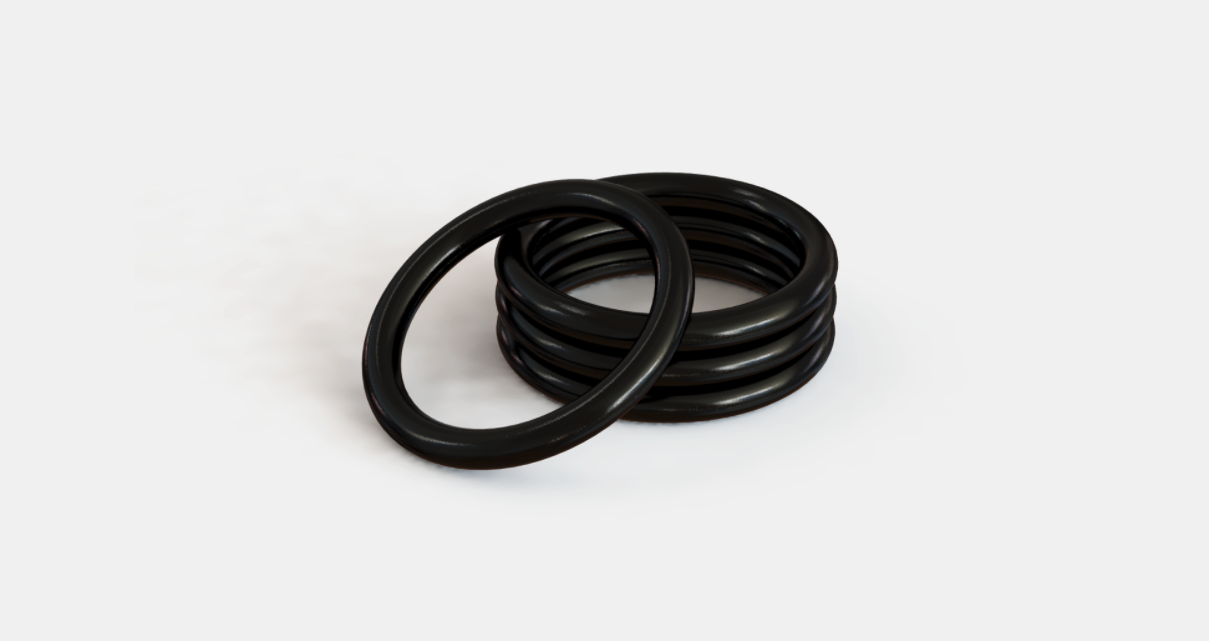How the HNBR Material is Developed and Modified
HNBR o-rings are high-performance seals that are actively used in multiple industries. HNBR is an upgraded — i.e. hydrogenated, hence the H — variation of nitrile butadiene rubber (NBR). The process saturates the butadiene segments of NBR with hydrogen, reducing the number of double bonds in NBR and creating a stronger material that better retains its key properties. As a result, HNBR o-rings have superior resistance to heat, ozone, chemicals, abrasion, oils, and greases, as well as improved mechanical characteristics.
Like other o-ring and sealing product materials, HNBR can be modified according to the industry and application by adjusting the amount of acrylonitrile (ACN) content — a monomer used in the manufacturing of plastics. For HNBR, ACN content is typically set around 36%. Lower ACN content results in better performance in low-temperature applications, but the material loses some resistance to fuels and lubricants. Increasing the amount of ACN has the opposite effect.
Learn more about HNBR. Explore compounds and characteristics here.
Industries and Applications Where HNBR O-Rings Excel
Because of its broad resistance set, and because those resistances and performance characteristics can be modified to increase resistance in key areas, HNBR o-rings are found in multiple industries and applications that include oil and gas, automotive, aerospace, manufacturing, chemical processing, and more.
Of these, the automotive industry is one of the largest-volume users of HNBR thanks to its strength and ability to maintain its heat-, chemical- and oil-resistant properties for long periods of time. A wide variety of automotive parts are made from HNBR such as belts and hoses, while many others use HNBR o-rings and gaskets in their construction (e.g. engine, air conditioning, suspension, and transmission systems all use HNBR seals).
In the oil and gas industry, HNBR o-rings and seals are put to work where other materials won’t perform. In high-intensity applications such as oil well drilling and deep environments that experience extreme pressure and temperatures, HNBR maintains its resistance despite consistent exposure to the fuels, oils, and lubricants used in exploration equipment. HNBR’s resistance to weathering and ozone (over standard NBR) and steam resistance are also applicable here, as oil field exploration occurs in some of the world’s harshest environments and for a prolonged period.
Ready to get started? Explore HNBR o-rings in stock now.
Where HNBR Isn’t the Ideal Material Choice
While HNBR o-rings can withstand some of the most challenging applications and environments known to man, there are just as many materials and instances where their characteristics and properties won’t deliver the performance needed. Examples include medical and pharmaceutical applications, environments with prolonged exposure to ultraviolet (UV) light, applications dealing with acetic or hydrochloric acid, and applications that use polar solvents, ketones, esters, and ethers.
For example, in the medical and pharmaceutical industry, HNBR shouldn’t be used because elements of it are toxic, such as ACN. While HNBR can be used in some medical equipment such as patient lifts and even prosthetics, applications that would be exposed to extreme and frequent cleaning or those where extreme temperatures above the max compound potential of 350ºF/180ºC should use other materials.
HNBR is not compatible with applications involving significant and prolonged exposure to UV light. For example, disinfection lamps for air and water purification systems should not use HNBR o-rings and seals. Polar solvents such as ketones, esters, and ethers are found in the cosmetics and paint industries, so equipment or machines producing those products may not benefit from HNBR. And when it comes to acetic acids (used in the manufacturing of inks and dyes and even in farming) and hydrochloric acid (in steel production and sugar processing), HNBR will not be able to maintain its performance.
Need a different sealing solution? Talk to an engineer today.
Work with the Experts for Your HNBR O-Rings
At Marco Rubber & Plastics, we understand that there are countless sealing materials and products available in the market — and that there are seemingly unlimited custom formulations of those materials. We offer a variety of proven HNBR o-ring compounds with different colors, shore A durometer (hardness) ratings, temperature ranges, and other features. We’ll even work with you on HNBR solutions for FDA compliance and other industry compliance requirements. And with high availability from our inventory of more than one billion seals and same-day shipping on many in-stock seals, the solution you need is just a few clicks away.
What matters most with HNBR and every other sealing material is maximizing its performance for your product and environment. Whether you’ve used HNBR o-rings in the past or are just starting to explore sealing solutions, our expert engineering team will develop the ideal HNBR formulation for your application. Our team has been working with HNBR for decades, and we’re ready to put that knowledge to work for you.
Seal Your Success with HNBR from Marco Rubber & Plastics
Explore HNBR Compounds | Buy HNBR O-Rings Online | Request a Custom Quote
